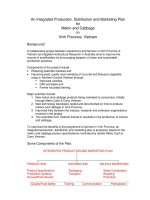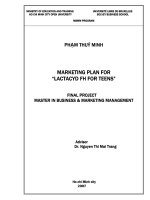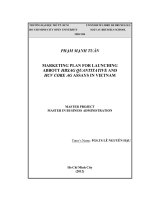Strategic Marketing Plan for Sparkle International English School
Bạn đang xem bản rút gọn của tài liệu. Xem và tải ngay bản đầy đủ của tài liệu tại đây (364.7 KB, 45 trang )
Strategic Marketing Plan for Sparkle International English School
Xiaoxiao Yuan
Bachelor’s Thesis of the Degree Programme in Business Management
Bachelor Degree of Business Administration
TORNIO 2012
ABSTRACT
KEMI-TORNIO UNIVERSITY OF APPLIED SCIENCES
Degree programme: Business Management Writer: Yuan, Xiaoxiao Thesis title: Strategic
Marketing Plan for Sparkle International English School Pages (of which appendices): 43 (2) Date:
19.1.2013 Thesis instructor: Wahlroos, Marita
The objectives of this research work are to learn how to make a strategic marketing plan and design
a strategic marketing plan for the Sparkle International English School. The strategic marketing
plan is developed in order to help the Sparkle International English School to develop its business.
I studied previous research and literature on the concept of internal analysis, external analysis, and
SWOT analysis for the theoretical discussions of this research work. This research work also
gathered and analyzed these related sources in order to find out what is needed in strategic
marketing plan, and how to build a feasible strategic marketing plan.
This Thesis uses both qualitative and quantitative research methods. An interview and a
questionnaire are the main data collection techniques in this research work. I interviewed two
general managers of two English schools in Langfang in order to get information and learn from
their experiences for the case company. I also distributed a questionnaire and sent 30
questionnaires to the students who are studying in the Sparkle International English School now.
The theoretical framework discusses all the concepts concerning the strategic marketing plan.
The result of this research work is a feasible strategic marketing plan in accordance with the
analysis of the Sparkle International English School. The strategic marketing plan based on the five
'Ps' method. In addition, new strategies are created for the Sparkle International English School on
the basis of this research.
Keywords: the Sparkle International English School, strategic marketing plan, analysis.
Type 1 60%
Type 2 15%
Type 3 10%
Type 4 5%
Type 5 10%
CONTENTS
ABSTRACT
1 INTRODUCTION 5
1.1 Background and Motivation 5
1.2 Research Objectives and Questions 6
1.3 Research Methodology 7
1.4 Structure of the Study 7
2 LITERATURE REVIEW 8
2.1Strategic Marketing Plan 8
2.2 Internal Analysis 9
2.3 Market Analysis 10
2.4 Customer Analysis 11
2.5 Competitor Analysis 13
2.6 SWOT Analysis 14
2.7 Strategic Marketing Plan Process 16
3 METHODOLOGIES 18
3.1 Research Methods 18
3.2 Data Collection 18
3.2.1 Data Collection of Interview 19
3.2.2 Data Collection of Questionnaire 20
3.3 Research Process 21
3.4 Limitations of the Research 22
4 STRATEGIC MARKETING PLANNING 23
4.1 Situation of English School in Chinese Market 23
4.2 Sparkle School Analysis 24
4.2.1 Internal Situation 24
4.2.2 Market Situation 26
4.2.3 Customer Situation 27
4.2.4 Competitor Situation 28
4.2.5 SWOT Analysis 29
4.3 Market Objectives 32
4.4 Strategic Marketing Plan Process 33
5 CONCLUSIONS 36
5.1 Conclusions 36
5.2 Suggestions for Future Research 39
REFERENCES 40
APPENDICES 42
1 INTRODUCTION
With the development of the world economy and internationalization, there is an increasing amount of
communications and cooperation between different countries. English is an international language,
and a great number of people in many countries in the world speak English. Therefore, the popularity
of English plays a vital role in the future development of a country.
Today, China is one of the largest economies in the world, and in order to promote the development of
international and national exchanges, China should pay increased attention to English education. With
the improvement of people's living standards and cultural quality, scores of Chinese people are also
aware of the importance of English. Many parents want their children to learn English and a lot of
Chinese students also are interested in learning English. Thus, lots of English schools have been built
in China and these schools have a great market potential.
1.1 Background and Motivation
The Sparkle International English School was opened in August 2012. I am involved in the operations
of this school in the position of a director of marketing. The School is located in Langfang, Hebei
province, China. The main operation is English teaching for people of different ages. This school also
has a consulting department for the students who want to go abroad and study. In the English teaching
part, IELTS courses, TOEFL courses, and courses in English Speaking are included. In addition, the
school also offers some professional English teaching, e.g. it provides services for the people who are
working in an English department at a college, university or company and need to improve their
English level. The Sparkle International English School also provides translation services. For the
consulting part, the school will offer some information and
suggestions about studying abroad for students who want to go abroad. In addition, the school can help
students who are preparing to go abroad and study by dealing with some documents, e.g. insurance,
and visa.
I chose this topic because I want to find out how to make a strategic marketing plan for the English
school. In this thesis, I make a complete strategic marketing plan for my case company. The region of
my marketing plan is in Langfang city which this school is located in. It is possible for me to analyze
the data because the economics and the education level is similar in the same city. In this thesis, I
analyze my case company situation and the market trends for making a holistic strategic marketing
plan.
1.2 Research Objectives and Questions
The objectives of this research are to learn how to make a strategic marketing plan and design a
strategic marketing plan for Sparkle International English School.
According to the objectives of this research, the research questions are as follows:
1. What is a strategic marketing plan?
The first sub question: What are main factors needed in the strategic marketing plan?
Literature and previous research is studied in order to find answers to this question.
2. How can a strategic marketing plan be made for Sparkle International English School?
The second sub question: What is the current market situation and the future market potential for the
English school?
For this question, I will do a market research to analyze the situation of the market to answer this
question. This analysis helps find out new methods to improve the competitiveness of the English
school.
1.3 Research Methodology
In my research, my main research question is a ‘How’ question. Therefore, I will use qualitative
research methods. “Qualitative marketing research seeks to explore and understand people’s attitudes,
perceptions, motivations and behaviors by constructing and then analyze data that are largely
qualitative in nature” (Kent 2007, 86).
In this qualitative research, I interviewed two Chinese English schools’ general managers to get
information for this research. I also circulated 30 questionnaires among the students who are studying
in the Sparkle International English School now.
1.4 Structure of the Study
This thesis is including 5 chapters. Chapter two is about literature review of strategic marketing plan.
Chapter three focuses on the methodologies of the research. Chapter four describes the strategic
marketing planning with a practical part. The last chapter includes the conclusions.
2 LITERATURE REVIEW
As was discussed in chapter one, the objectives of this thesis are to learn how to make a strategic
marketing plan and design a strategic marketing plan for Sparkle International English School.
Theoretical knowledge about strategic marketing plan is expounded. I also discuss the situation
analysis, and it includes five parts, i.e. internal analysis, market analysis, customer analysis, competitor
analysis, and SWOT analysis. In addition, a strategic marketing plan process is discussed.
2.1Strategic Marketing Plan
I need to make a strategic marketing plan for the case company, and making the strategic marketing
plan is in a central position in this research work. Therefore, it is necessary to understand the basic
knowledge of strategic marketing plan. Alsem (2007, 6) points out that the definition of marketing is
understood in different ways. First, as an organizational culture, marketing drives the organization to
make a basic promise to serving the needs of customers. Second, as a strategy, define the target
markets and product positioning. Third, as a tactics, marketing is the day-to-day activities of the four
marketing tools: product development, pricing, distribution, and communication. “The marketing
means that the achievement of corporate goals through meeting and exceeding customer needs better
than the competition” (Jobber 1998, 4). Gilligan and Wilson (2003, 53) demonstrate strategy means
organizations need to know where they want to go and then decide how best to get there. Strategic
marketing can be interpreted to the planner deciding – with complete clarity – in which markets the
organization wants to compete, and then how exactly it will do this. “Strategic marketing plan is
typically applied to the definition of marketing objectives and achieve these objectives” (Gilligan &
Wilson 2003, 43).
According to Kotler (2000, 86-89), strategic marketing plan can be understood as follows: based on the
current market environment and opportunity to select the target market, design strategies and achieve
marketing objectives. Furthermore, the process of strategic marketing plan includes internal analysis,
market analysis, customer analysis, and competitor analysis. In addition, a strategic marketing plan
should adapt to the changes of the market. Therefore, designing a useful strategic marketing plan will
help the case company to develop their business.
2.2 Internal Analysis
Internal Analysis is the first step to build a strategic marketing plan, so the case company’s current
situation needs to be clarified. Aaker and McLoughlin (2010, 99) point out that the goal of internal
analysis is to identify organizational strengths, weaknesses, constraints, and ultimately, to develop
strategies. In this research work, the internal analysis can provide a detailed understanding of the case
company.
Aaker and McLoughlin (2010, 99) point out that the internal analysis includes four aspects. The first,
financial performance can provide an initial approximation. The second, an analysis of other
performance element, i.e. customer satisfaction, product quality, brand association, relative cost, new
products, and employee capability, can provide a link to future profitability. The third, an analysis of
the strengths and weaknesses and these can be the basis of current and future strategies. The fourth is
an identification of the threats and opportunities in the company. The last section is to find out the
relationship between strategy and the analysis of the organization, competitors and the market. (Aaker
& McLoughlin 2010, 99.) “A successful strategy is when organization strengths match market needs
and against with the competitor's weakness” (Aaker & McLoughlin 2010, 99).
According to Alsem (2007, 57), the internal analysis should start from objectives. Alsem (2007, 57)
also point out that set an objective has numerous of functions. First, within the company it serves as a
guideline for the company, so the company will know what they wants to achieve. Therefore, it has a
communicative or motivating function. The second, it is a tool for the planning process. According to
Gilligan and Wilson (2003, 312), there are four aspects influence on organizational objectives and
strategy, i.e. external influences, organizational culture, nature of the business, individuals and groups.
Alsem (2007, 57-58) also point out that an objective should have five requirements, i.e. Specific,
Measurable, Ambitious, Realistic and Timed. “Specific relates to being precise about what the
company is going to achieve. Measurability means that it is possible to document whether the objective
was achieved. Ambitious means that the objectives should not be set too low. Realistic means that the
objective should be reasonably possible to achieve. The last, an objective should be defined for a
specific time period.” (Alsem 2007, 57-58.)
2.3 Market Analysis
“The business market consists of all the organizations that acquire goods and services used in the
production of other products or services that are sold, rented, or supplied to others” (Kotler 2000, 192).
Aaker and McLoughlin (2010, 60) also suggest that market analysis should be based on the customer
and competitor analysis to make strategies about a market and its dynamics. According to Aaker and
McLoughlin (2010, 60), the first objective of a market analysis is to decide the attractiveness of a
market to current and potential participants. Another objective of market analysis is to understand the
dynamics of the market. “The business market consists of all the organizations that acquire goods and
services used in the production of other products or services that are sold, rented, or supplied to others”
(Kotler 2000, 192). Gilligan and Wilson (2003, 350) point out that there are five factors that can
influence the market, i.e. Product, price, place, promotion, partnerships.
Aaker and McLoughlin (2010, 61) point out that a market analysis will be decided by the context, and
include the following dimensions: “Emerging submarket; actual and potential market and submarket
size; market and submarket growth; market and submarket profitability; cost structure; distribution
systems; trends and developments; key success factors” (Aaker & McLoughlin 2010, 61).
Market analysis is also a part of external analysis. Market analysis can help the case company to know
the current market situation. Market analysis also can be guidance for creating a strategic marketing
plan.
2.4 Customer Analysis
“In order to grow the profits and sales, the companies have to spend considerable time and resources
searching for new customers”(Kotler 2000, 46). Alsem (2007, 73) points out that the creation of
customer value must be a company’s central focus. This is the reason why the external analysis should
start with an analysis of the target customer. “In most strategic marketing- planning contexts, the first
logical step is to analysis the customers” (Aaker &McLoughlin 2010, 26). According to Aaker and
McLoughlin (2010, 26), the customer analysis can be usefully divided into three parts. The first one is
market segments, the second one is customer motivations, and last one is unmet needs. Segmentation is
the key to developing a competitive advantage. “Segmentation means it is the identification of
customer groups that respond differently from other groups to competitive offerings” (Aaker &
McLoughlin 2010, 26).
After identifying the customer segments, the next step is to consider the customer motivations. Thus,
the customer motivation analysis is very important for the customer analysis. The process of customer
motivation analysis illustrates in Figure 1. “The customer motivation analysis starts with the task of
identifying motivations for a given
segment” (Aaker and McLoughlin 2010, 32).
Assign
Strategic
Roles to
Motivations
Assess
Motivation
Importance
Group and
Structure
Motivations
Identify
Motivations
Figure1. Customer Motivation Analysis (Aaker
& McLoughlin 2010, 32)
“Qualitative research is the most powerful tool in understanding customer motivation, it can involve
focus-group sessions, in-depth interviews, customer case studies, or ethnographic research. The
concept is to search for the real motivations.” (Aaker & McLoughlin 2010, 34.) According to Alsem
(2007, 79), A customer analysis, also called “market research”, the problem in market research is that
it is difficult for people to indicate what the customer might like in the future. Thus, data from a
customer analysis should not be used as a direct guideline for action, it should be interpreted and
subsequently combined with other sources. (Alsem 2007, 79.) “ Marketing research is at the heart of
marketing decision-making and it is important to understand what it involves and its place within the
organization” (Brassington & Pettitt 2007, 141).
Alsem (2007, 99) also suggests the research phases, it illustrates in Figure 2.
In this research work, I use both qualitative and quantitative research as my research methods. More
details can see from the next chapter. In sum, the customer is the one of the important roles in business.
Therefore, companies must know what does customer needs and wants, then satisfied customers and
develop new customers.
Qualitative research
Problem inventory and relevant factors
Necessary to know “percentages”?
Quantitative research
Quantification of results and differences between segments
Need for clarification of quantitative result?
Qualitative research
Further problem analysis
Figure 2. Research phases (Alsem 2007, 99)
2.5 Competitor Analysis
According to Aaker and McLoughlin (2012, 42), competitor analysis is the second element of external
analysis, the goal of competitor analysis will influence the development of successful business
strategies and the competitor analysis should focus on the identification of threats, opportunities.
Moreover, strategic uncertainties should be created by competitor weaknesses, or strengths. (Aaker &
McLoughlin 2012, 42.) “Competitive analysis should be a central element of the marketing planning
process” (Gilligan and Wilson 2003, 177).
Aaker and McLoughlin (2010, 42) also point out that before doing a competitor analysis, researchers
should start with identifying current and potential competitors. There are two different ways to identify
the current competitors. The first way is to exam the perspective of the customer who need make
choices among competitors. The second way attempts to place competitors in strategic groups. After
competitors are identified, the focus turn to attempting to understand competitor and competitor
strategies. (Aaker & McLoughlin 2012, 42.)
“The goal of a competitor analysis is to obtain insight into the strengths and weaknesses of the most
important competitors and their expected strategies” (Alsem 2007, 145). According to Alsem (2007,
134), the methods for identifying the competitors include competition-based methods and customer-
based methods. In addition, competition-based methods include management opinion and strategic
groups. Customer-based methods include direct identification research with customers, brand
switching, and positioning research. (Alsem 2007, 134.)
2.6 SWOT Analysis
“The overall evaluation of a company’s strengths, weaknesses, opportunities, and threats is called
SWOT analysis” Kotler (2000,76). “A SWOT analysis therefore is different from external and internal
analyses that are being completed. Both of those analysis combined may be designated as the situation
analysis.” (Alsem 2007, 174.) Gilligan and Wilson (2003, 88) also point out that SWOT analysis is one
of the frequently used tools in the marketing planning process. The quality of the outcomes often
suffers because of the relatively superficial mode in which it is conducted.
According to Gilligan and Wilson (2003, 89), SWOT analysis needs to achieve two objectives. The
first, dividing useful data from the merely interesting. The other
objective is to find out what management must do and develop its distinctive competencies within each
of the market segments. (Gilligan & Wilson 2003, 89.)
Figure 3 is the steps in the SWOT analysis (Alsem 2007, 177)
1. Only include the most important issues.
2. Category the points in order of importance.
3. Ensure that adequate supporting evidence is available for each point.
4. Strengths and weaknesses should be relative to the competitors.
Figure 3. Steps in the SWOT analysis (Alsem 2007, 177)
“TOWS analysis can be seen to add another dimension to the traditional thinking about strengths,
weaknesses, opportunities and threats, a fundamental question can be raised about just how useful this
sort of analysis is within today’s markets” (Gilligan & Wilson 2003, 102).
Figure 4. The TOWS matrix (adapted from Weihrich, 1982) (Gilligan & Wilson 2003, 102)
2.7 Strategic Marketing Plan Process
Gilligan and Wilson (2003, 61) point out that the planners should think about how to improve levels of
commitment and support to the planning process. As figure 5 discussed:
Internal
Elements
External
Elements
Organizational
Strengths
Organizational
Weaknesses Strategic options Environmental
Opportunities (and risks) S-O: Strengths can be used to capitalize or build upon existing or emerging
opportunities W-O: The strategies developed need to overcome organizational weaknesses if existing or
emerging opportunities are to be exploited Environmental
Threats S-T: Strengths in the organization can be used to minimize existing or emerging threats W-T: The
strategies pursued must minimize or overcome weaknesses and, as far as possible, cope with threats
A commitment to
ownership of the
planning process and a
fundamental
recognition of its
strategic and tactical
value
A growing enthusiasm
for the planning process
and recognition of its
strategic and tactical
value
Compliance and an
involvement with the
plan
A general and often
unspecific resistance to
the plan
An overt opposition to
the plan and the planning
process
Figure 5. The
ladder of planning
commitment and
support (Gilligan &
Wilson 2003, 61)
Alsem (2007, 21) also point out that the strategic marketing planning process. The first, companies
should know their mission, value, strategies, and market definition. The second, it includes internal
analysis and external analysis. The third, the research should work from analysis to strategy. The
fourth, corporate objectives and strategies together. The fifth, marketing objectives and marketing
strategies. The last, objectives and strategies for marketing instruments and organization and
implementation of marketing. According to my research, my strategic marketing plan for the Sparkle
International English School includes internal analysis, market analysis, customer analysis, competitor
analysis and SWOT analysis.
3 METHODOLOGIES
Research methodologies are discussed here, including four sub-chapters. The first, research methods
chapter describes qualitative and quantitative research methods, and the second, i.e. the data collection
chapter, discusses the methods of data collection. The third, the research process chapter describes the
interview and questionnaire methods. Lastly, the limitations of the research are discussed.
3.1 Research Methods
In this research work, research methods help me address the research objectives and answer the
research questions. As was discussed in the first chapter, both qualitative and quantitative research
methods are used in this research work.
According to Kent (2007, 86), the goal of qualitative marketing research is to explore and understand
people’s attitudes, perceptions, motivations and behaviors by constructing and analyzing data and
qualitative research is a major part in supporting marketing decisions. Kent (2007, 117) also points out
that quantitative marketing research seeks to evaluate the extent of, or changes in, marketing
phenomena and to test ideas in order to make predictions. Moreover, the basis of quantitative
marketing research is the construction and analysis of data.
3.2 Data Collection
According to Kent (2007, 69), data means systematic records and should be constructed by individuals.
It may be judged and collected in many different ways. In addition, data includes qualitative data and
quantitative data. Qualitative data should be composed of
words, phrases, text or images. Moreover, quantitative data are originated from numerical records.
Therefore, the distinction between qualitative data and quantitative data is that qualitative data describe
the essential characters of things and cannot be represented by numerical records. Quantitative data
describe the number of characteristics of the phenomenon, and must use the numeric performance.
(Kent 2007, 69-71.)
Collis and Hussey (2009, 73) point out that data can divide into primary data and secondary data.
Primary data are the data derived from an original source, i. e. a researcher’s experiment, surveys or
interviews. Secondary data are data generated from an existing source, i. e. publications, databases or
internal records. (Collis & Hussey 2009, 73.) Therefore, the main sources of this research work are the
primary data. Moreover, I also use secondary data to assist this work.
In sum, in this research work, the main methods of qualitative data collection are the interviews and the
main methods of quantitative data collection are the questionnaires. Additional theoretical knowledge
of these methods is described in the next sub-chapter and more detailed information is provided in the
appendices.
3.2.1 Data Collection of Interview
Collis and Hussey (2009, 144) define that interview is a method for collecting data in which selected
interviewees are asked questions in order to find out what they do, think or feel. Generally, Interview
consist of individual interview and group interview. In-depth interview is the main method of
obtaining qualitative data in a successful way. Aaker, Kumar and Day (2006, 192) point out that an in-
depth interview means that interviews are conducted face to face with the interviewee, in which the
subject matter of the interview is explored in detail. In this research work, I do the individual
interview, as the introduction chapter presented, I interview two Chinese English Schools’ general
manager, and the objective of these interviews is to acquire experience from them. From my point of
view, interview skills are very important if the researcher wants to get
useful information. According to Easterby-Smith, Thorpe and R. Jackson (2008, 127), there are six
issues that may affect the outcome of an interview and researcher should pay attention to these issues.
The first issue is creating trust from the interviewees, and this is the basic requirement and an
important element. The second issue is social interaction which is also one of the important factors that
could be influence the interview process. Using the appropriate language is a third element that can be
important. The fourth element is the fact that getting access may have an effect on the interview. The
fifth element influencing interview is choosing the location for the interviews. Recording interviews in
the last factor that may affect the outcome of an interview. (Easterby-Smith et al. 2008, 127.)
3.2.2 Data Collection of Questionnaire
Questionnaire is the main method of quantitative research method, according to Kent (2007, 151). In
order to capture data, researchers put questions to other people in the form of a questionnaire
document, and this instrument is called questionnaire. In this research work, I use the questionnaire
method as my quantitative research method and the questions of the questionnaire can be seen in the
appendices. Kent (2007, 152) suggests the steps of questionnaire design, and the design is illustrated in
Figure 6.
Specifying the information needed
Deciding the method of questionnaire administration
Determining the content, format and wording of each question
Creating a draft of the complete questionnaire
Testing the questionnaire
Figure 6. Steps in questionnaire design (Kent 2007, 152)
As figure 6 shows, the first step of questionnaire design is specifying the information, which means
that the researcher should know what information is needed for the research and focus on this point
when designing the questionnaire. Deciding the method of questionnaire administration is the second
step, and there are four ways to choose the method of questionnaire administration. The ways are as
follows: face to face, over the phone, postal questionnaire, or electronic questionnaires, in order to get
the reliable information and ensure the efficiency of the work. In this research, I use the face to face
method, as the introduction discussed, because I send the questionnaires to the students who are
studying in the Sparkle International English School now. The third step is determining the content,
format and wording of each question, which means that the researcher should think about the wording,
format in order to layout of each question. Creating a draft of the complete questionnaire is another
important step of questionnaire design, this means the researcher should pay attention on the
sequencing of the questions and ensure that the interviewer will know what is the next relevant
question to answer. In addition, when the questionnaire draft is complete and approved, it needs to be
tested. (Kent 2007, 152.)
According to Ghauri and Grønhaug (2005, 127), there are four steps of constructing questionnaires.
The first step is to specify what type of information is needed. Secondly, researchers should consider
whether the questionnaire is going to be disguised or undisguised. Thirdly, the construction of
individual questions should be considered. Fourthly, researchers should consider how the questions are
to be answered. In this research work, I use the system of Kent to design the questionnaire.
3.3 Research Process
The case company of this research is the Sparkle International English School in China. As was
described in the first chapter, The Sparkle English School was opened in 2012, and therefore it is a
new school and the school needs to be improved. In addition, I am involved in the operations of this
school in the position of a director of marketing. From
this point of view, I decided to make a strategic marketing plan for the Sparkle International English
School after I talked with the CEO of the school.
3.4 Limitations of the Research
During the development of the research work, there were still some difficulties and problems. In the
literature part in chapter two, there is extensive information about the strategic marketing plan,
therefore, it was really difficult to choose a most proper theory in order to match the research work.
Moreover, as discussed in the first chapter, the Sparkle International English School is a new company.
Thus, it is difficult to analysis all the weaknesses, because it is still on the way to develop. Besides,
because of the district and time limitation, I did the interview through the internet. From this point of
view, the information that I collected through the interview was not particular.









